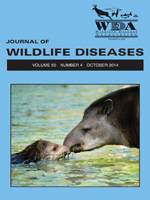Mycoplasmas are an important cause of upper respiratory tract disease (URTD) in desert tortoises (Gopherus agassizii) and have been a main focus in attempts to mitigate disease-based population declines. Infection risk can vary with an animal's population of origin, making screening tests popular tools for determining infection status in individuals and populations. To provide additional methods for investigating URTD we developed quantitative PCR (qPCR) assays specific for agents causing clinical signs of URTD: Mycoplasma agassizii, Mycoplasma testudineum, and Testudinid herpesvirus 2 (TeHV2) and tested necropsied desert tortoises housed at the Desert Tortoise Conservation Center in Las Vegas, Nevada, USA, as well as wild desert tortoises (n = 3), during 2010. Findings were compared with M. agassizii enzyme-linked immunosorbent assay (ELISA) data. Based on qPCR, the prevalence of M. agassizii was 75% (33/44) and the prevalence of TeHV2 was 48% (20/42) in the evaluated population. Both agents were also present in the wild tortoises. Mycoplasma testudineum was not detected. The M. agassizii ELISA and qPCR results did not always agree. More tortoises were positive for M. agassizii by nasal mucosa testing than by nasal flush. Our findings suggest that mycoplasmas are not the only agents of concern and that a single M. agassizii ELISA or nasal flush qPCR alone failed to identify all potentially infected animals in a population. Caution should be exercised in using these tests for disposition decisions.
How to translate text using browser tools
1 October 2014
MOLECULAR METHODS TO DETECT MYCOPLASMA SPP. AND TESTUDINID HERPESVIRUS 2 IN DESERT TORTOISES (GOPHERUS AGASSIZII) AND IMPLICATIONS FOR DISEASE MANAGEMENT
Josephine Braun,
Mark Schrenzel,
Carmel Witte,
Larisa Gokool,
Jennifer Burchell,
Bruce A. Rideout
ACCESS THE FULL ARTICLE

Journal of Wildlife Diseases
Vol. 50 • No. 4
October 2014
Vol. 50 • No. 4
October 2014
desert tortoise
Mycoplasma
qPCR
Testudinid Herpesvirus 2
upper respiratory tract disease




